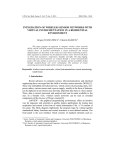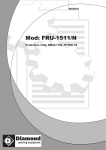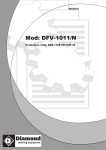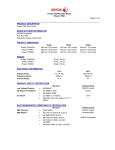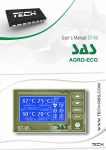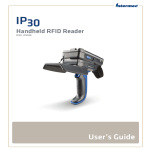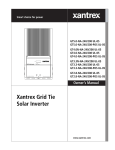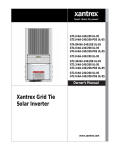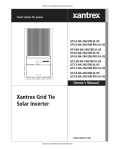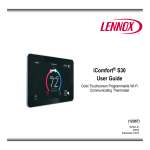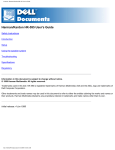Download MEPL-MDIN-UK-DFV-1011_N
Transcript
02/2014 Mod: DFV-1011/N Production code: E2 RDA-110E ER 06DI 52 CONVECTION - STEAM OVEN INSTRUCTIONS FOR THE INSTALLATION, USE AND MAINTENANCE C O N V E C T I ON+ HUM IDIF ICAT ION C OM BI DIRECT 305/105/110/115 ANALOGIC UK 5 x 2/3 GN / 5-10-15 x 1/1 GN ANALOGIC WARNING ! Before making any type of connection of this equipment (electrical or hydraulic), carefully read the instructions in this manual. The installation must be carried out only by qualified technical personnel. FOREWORD The contents of this manual are generic and not all the functions described may be available on your product. The manufacturer declines all responsibility for possible inaccuracies contained in this pamphlet, due to printing or copy errors. We reserve the right to make on our own products those changes to be considered necessary or useful, without jeopardizing the essential characteristics. Read the instructions for use very carefully paying particular attention to the rules concerning safety devices. This appliance must only be used for what it has been designed for and built for and that is: all baking of dishes and regenerating pre-cooked and/or frozen food. 28 5 x 2/3 GN / 5-10-15 x 1/1 GN ANALOGIC INDEX 0.0A Dimensions 5x2/3 GN 0.0B Dimensions 5x1/1 GN 0.0C Dimensions 10x1/1 GN 0.0D Dimensions 15x1/1 GN 0.0E Dimensions 5x2/3 GN + stand 0.0F Dimensions 5x1/1 GN + stand 0.0G Dimensions 10x1/1 GN + stand INSTALLATION 1.0 Declaration of Conformity 1.1 European Directive ROHS 2011/65/UE 1.6 Technical data for electrical connection 2.0 Installing the appliance 2.2 Electrical connection 2.3 Hydraulic connection – water inlet 2.3A Technical data table water connection 2.4 Hydraulic connection- water drainage 3.0 Control and safety devices 3.1 Spare parts replacing 3.2 Checking the functions USE AND MAINTENANCE 4.1 Programming and operation mod. Convection + Humidification 4.1A Description control panel components Convection + Humidification 4.2 Programming and operation mod. Combi Direct 4.2A Description control panel components Combi Direct 4.4 Starting the oven 4.5 Auxiliary commands and controls 4.6 Turning the oven off 9.0 Maintenance 9.1 What to do in the case of a breakdown and/or extended period of non use 10.0 Cooking tips 10.1 Remedies to cooking hitches 29 5 x 2/3 GN / 5-10-15 x 1/1 GN ANALOGIC A- Electrical connection B- Water inlet Ø 3/4” C- Water drainage Ø 40 mm D- Cooking chamber relief valve Ø 60 mm 5 x 2/3 GN 0.1A Dimensions mod. 5 x 2/3 GN Model Dimensions Capacity Trays distance 5 x 2/3 GN Electric cm 71 x 65 x h 58 5 x 2/3 GN 5 x 1/2 GN 67 mm 30 5 x 2/3 GN / 5-10-15 x 1/1 GN ANALOGIC A- Electrical connection B- Water inlet Ø 3/4” C- Water drainage Ø 40 mm D- Cooking chamber relief valve Ø 60 mm 5 x 1/1 GN 0.1B Dimensions mod. 5 x 1/1 GN Model Dimensions Capacity Trays distance 5 x 1/1 GN Electric cm 71 x 83 x h 58 5 x 1/1 GN 10 x 1/2 GN 67 mm 31 5 x 2/3 GN / 5-10-15 x 1/1 GN ANALOGIC A- Electrical connection B- Water inlet Ø 3/4” C- Water drainage Ø 40 mm D- Cooking chamber relief valve Ø 60 mm 10 x 1/1 GN 0.1C Dimensions mod. 10 x 1/1 GN Model Dimensions Capacity Trays distance 10 x 1/1 GN Electric cm 71 x 83 x h 91 10 x 1/1 GN 20 x 1/2 GN 67 mm 32 5 x 2/3 GN / 5-10-15 x 1/1 GN ANALOGIC A- Electrical connection B- Water inlet Ø 3/4” C- Water drainage Ø 40 mm D- Cooking chamber relief valve Ø 60 mm 15 x 1/1 GN 0.1D Dimensions mod. 15 x 1/1 GN Model Dimensions Capacity Trays distance 15 x 1/1 GN Electric cm 75 x 85 x h 156 15 x 1/1 GN 30 x 1/2 GN 67 mm 33 5 x 2/3 GN / 5-10-15 x 1/1 GN ANALOGIC 5 x 2/3 GN + SG-53R 0.1E Dimensions mod. 5 x 2/3 GN + stand Model Dimensions Capacity Trays distance 5 x 2/3 GN Electric cm 71 x 65 x h 130 5 x 2/3 GN 5 x 1/2 GN 67 mm 34 5 x 2/3 GN / 5-10-15 x 1/1 GN ANALOGIC 5 x 1/1 GN + SG-51R 0.1F Dimensions mod. 5 x 1/1 GN + stand Model Dimensions Capacity Trays distance 5 x 1/1 GN Electric cm 71 x 83 x h 130 5 x 1/1 GN 15 x 1/2 GN 67 mm 35 5 x 2/3 GN / 5-10-15 x 1/1 GN ANALOGIC 10 x 1/1 GN + SG-51R 0.1G Dimensions mod. 10 x 1/1 GN + stand Model Dimensions Capacity Trays distance 10 x 1/1 GN Electric cm 71 x 83 x h 163 10 x 1/1 GN 20 x 1/2 GN 67 mm 36 5 x 2/3 GN / 5-10-15 x 1/1 GN ANALOGIC installation 1.0 DECLARATION OF CONFORMITY The Manufacturer declares that the appliances conform to the EEC norms. They must be installed in accordance with current standards, especially regarding aeration of the premises and the exhaust gas evacuation system. Note: The Manufacturer declines all and every responsibility for any direct damages caused by: an incorrect use, wrong installation or bad maintenance. 1.1 EUROPEAN DIRECTIVE ROHS 2011/65/UE This appliance is marked according to the European directive 2011/65/UE on Waste Electrical and Electronic Equipment (WEEE). By ensuring this product is disposed correctly, you will help prevent potential negative consequences for the environment and human health, which could otherwise be caused by inappropriate waste handling of this product. The symbol on the product, or on the documents accompanying the product, indicates that this appliance may not be treated as household waste. Instead it shall be handed over to the applicable collection point for the recycling of electrical and electronic equipment. Disposal must be carried out in accordance with local environmental regulations for waste disposal. 1.6 TECHNICAL DATA FOR ELECTRICAL CONNECTION Model Power loading and voltage no. and motor power Heating power Absorbed current Feed cable section 5 x 2/3 GN 5 kW 400 V+3N~50/60 Hz 1 x 250 W 4.8 kW 8.5 A 5 x 1.5 mm2 5 x 1/1 GN 6 kW 400 V+3N~50/60 Hz 1 x 250 W 5.8 kW 10.0 A 5 x 2.5 mm2 10 x 1/1 GN 12 kW 400 V+3N~50/60 Hz 2 x 250 W 11.6 kW 20.0 A 5 x 4.0 mm2 15 x 1/1 GN 16 kW 400 V+3N~50/60 Hz 3 x 250 W 14.7 kW 25.0 A 5 x 6.0 mm2 37 5 x 2/3 GN / 5-10-15 x 1/1 GN ANALOGIC 2.0 INSTALLING THE APPLIANCE Read this handbook through carefully as it provides important information to guarantee a safe installation, use and maintenance. The appliance must be installed only and exclusively by qualified personnel following the instructions given herein and in compliance with current laws in force. The water, electricity and the premises on which the appliances are installed comply with the relative installation and safety standard. Install the oven on aerated premises and level with the adjustable feet, keeping at least 6 cm between the bottom of the oven and the supporting surface on which the feet stand. Fig. 2.0 Install the appliance in a position that allows access to the right side for installation, maintenance and technical assistance. Maintain the minimum distances between the oven walls, (rear and right side) and either the brick walls or the other appliances, as illustrated in figure 2.0A. Take the protective film off the stainless steel parts by hand before starting the appliance. Do not use abrasive substances and/or metal objects. Fig. 2.0A If the oven is placed on its supports, supplied by us on request, make sure the centre hole of the feet snap on to the support pin which will guarantee stability, (Fig. 2.0A). 38 5 x 2/3 GN / 5-10-15 x 1/1 GN ANALOGIC 2.2 ELECTRICAL CONNECTION When the appliance is delivered it is set to work at the voltage given on the rating plate affixed on the right side of the appliance. The terminal board used for connecting can be accessed from the right of the appliance, removing the side panel. Before connecting the cable, remove the steel protection fixed to the ovens base with its specific screws, (see Fig. 2.2A) insert the cable in the clamp-connector and then in the terminal board zone, passing through the hole with the gasket near the terminal board. Once the electric connection has been carried out, reassemble the steel protection previously removed. The specifications of the flexible cable for the electrical connection should be no lower than those of the type with rubber insulation H07 RN-F, with the cross section of the wires as given in the technical data. Install a circuit breaker of a suitable capacity upstream from the appliance, making sure it has an opening between the contacts of at least 3 mm. Fig. 2.2 It is essential to connect the appliance to an effective earthing system; (Fig. 2.2) for this purpose the relative terminal with the symbol to which the earth wire is to be connected is on the terminal board. The effectiveness of the equipotential system of which the appliance is part of, must conform to current standards. Connect using the screw you find near the power cable’s relief cable strain, marked with the word EQUIPOTENTIAL. The Manufacturer declines all and every responsibility if this important accident prevention norm is not complied with 2.2A-CHECKING MOTOR ROTATION DIRECTION (only for three-phase motors). Fig. 2.2A Check that the fans’ rotation direction is the same as that of the arrow on the stainless steel air-conveying panel, located inside the oven. If they are rotating in the opposite direction, reverse two phases on the supply terminal board. 39 5 x 2/3 GN / 5-10-15 x 1/1 GN ANALOGIC 2.3 HYDRAULIC CONNECTION – WATER INLET The ovens have a water inlet coupling at the back. Always install an on-off valve between the appliance and the water mains, making sure it is easy to operate. We also suggest installing a cartridge filter on the water inlet pipe. Always connect to the cold water. In Convection + Humidification models, the solenoid valve (B) supplies the steam generation in Combination cycle (Fig. 2.3A). In Combi Direct models, the solenoid valve (A) supplies the steam generation in Steam cycle, the solenoid valve (A1) in Combination cycle and the solenoid (B) supplies the steam condensation system that comes out of the drainpipe (Fig. 2.3B). The water must be suitable to human use with the following characteristics: Fig. 2.3A Temperature: included between 15 – 20°C Total hardness: included between 4 and 8 °f (French degrees), it is advisable to install a softener upstream from the appliance that will maintain the hardness level at the mentioned values. The oven’s running with water that has a higher hardness level will not be long before scale forms on the walls of the oven and in this case the technical assistance required to repair such damage is not covered by the guarantee. Fig. 2.3B Pressure: included between 100 and 200 KPa (1 – 2 bar). Attention higher water pressure values result in increased water consumption and can compromise the correct functioning of some components. Maximum chloride concentration (Cl-): less than 150 mg/litre. Chlorine concentration (Cl2): less than 0.2 mg/litre. pH: more than 7. Water conductivity: included between 50 and 2000 µS/cm. Attention: Water treatment systems that bring to different values to the ones above mentioned automatically invalidate the guarantee. The use of dosing systems designed to prevent the build-up of lime-scale in pipes (i.e. polyphosphate dosing systems) is also prohibited since it may impair the performance of the appliance. 40 5 x 2/3 GN / 5-10-15 x 1/1 GN ANALOGIC 2.3A TECNICAL DATA TABLE FOR THE WATER SYSTEM Convection + Humidification 305 5 x 2/3 GN 105 5 x 1/1 GN 110 10 x 1/1 GN 115 15 x 1/1 GN Condensation flow rate regulator Optional - Fig. 3.0G Ø 0.7 mm Ø 0.7 mm Ø 0.7 mm Ø 0.7 mm Combined cycle water flow rate regulator Fig. 2.3A Ø 0.4 mm Ø 0.4 mm Ø 0.4 mm 2 x Ø 0.4 mm 305 5 x 2/3 GN 105 5 x 1/1 GN 110 10 x 1/1 GN 115 15 x 1/1 GN Condensation flow rate regulator Fig. 3.0G Ø 0.7 mm Ø 0.7 mm Ø 0.7 mm Ø 0.7 mm Steam water flow rate regulator Fig. 2.3B Ø 0.5 mm Ø 0.5 mm 2 x Ø 0.5 mm 2 x Ø 0.55 mm Combined cycle water flow rate regulato Fig. 2.3B Ø 0.4 mm Ø 0.4 mm Ø 0.4 mm 2 x Ø 0.4 mm Combi direct 41 5 x 2/3 GN / 5-10-15 x 1/1 GN ANALOGIC 2.4 PLUMBING – WATER DRAINAGE Drainage for the water is at the back of the oven and must be connected directly to the end of the stainless steel drainpipe. The drain must have no trap and be made in rigid pipes that can withstand a temperature of 110°C. Under no circumstances must pipe diameter be reduced. The actual pipe should be at atmospheric pressure with the appropriate funnel type air intake. If the drainpipe is clogged for any reason steam can escape from the door and bad smells can be created inside in the oven. Important: The drain system must be installed so that any vapours coming from the open drain do not enter the aeration vents under the appliance. (Fig. 2.4 and 2.4A). Fig. 2.4 Fig. 2.4A 42 5 x 2/3 GN / 5-10-15 x 1/1 GN ANALOGIC 3.0 CONTROL AND SAFETY DEVICES The ovens are equipped with a set of control and safety devices for the electric and hydraulic circuits. 3.0A 2A fuse: it is in the auxiliary circuit to protect against short circuiting of the electrical system and is inside its own support on the contactor’s fixing bracket. 3.0D Motor overload protection: a thermal probe disengages the motor when, for various reasons, there is an overload. When the overload protection triggers it stops the motor and also disconnects the heating elements or the gas valve. The probe is reset automatically when motor temperature drops. Fig. 3.0G 3.0E Oven safety thermostat: disconnects the heating element or the gas valve when anomalies related to overheating occur. Subsequent re-set will have to be done manually when causes for thermostat operation have been determined. 3.0F Door micro switch: it stops the oven working when the door is opened. 3.0G Thermostat system for condensation of discharge steam: (optional in convection + humidification models): it comprises a solenoid valve controlled by a thermostat whose sensor is housed in contact with the discharge. The solenoid valve, via the injector (G), lets cold water into the drainpipe to condense the steam when a temperature of 90°C is reached (Fig. 3.0G). Fig. 3.0H 3.0H Oven relief valve: its job is to adjust humidity inside the cooking chamber. The valve is manually activated acting on the knob (A) (Fig.3.0H) on top of the door. 43 5 x 2/3 GN / 5-10-15 x 1/1 GN ANALOGIC 3.1 REPLACING SPARE PARTS Before starting to replace spare parts make sure, for safety reasons, that the electricity main switch is off and that the water on-off valve is closed. 3.2 CHECKING THE FUNCTIONS Start the appliance following the “USER MANUAL”. Test the water pipes for leaks. It is essential to explain to the user exactly how the appliance works and to supply him with the instruction handbook that he must follow when using the oven. 44 5 x 2/3 GN / 5-10-15 x 1/1 GN ANALOGIC USE AND MAINTENANCE For a correct comprehension of the terminology used in the following paragraphs, we underline that cooking phase is the period of time in which the oven carries out one of the following cooking modes: Convection hot forced air (temperature range between 50 - 270°C) Combination hot forced air and steam (temperature range between 50 - 270°C) Steam (temperature range between 50 - 100°C) 45 5 x 2/3 GN / 5-10-15 x 1/1 GN ANALOGIC 4.1 PROGRAMMING AND OPERATION mod. Convection + Humidification Convection forced hot air cycle (temperature range between 50-270°C) Turn the cycle selector knob (A) to the symbol shown on the left and select the cooking temperature using thermostat knob (B). Combination cycle, hot air and steam (temperature range between 50-270°C) Turn the cycle selector knob (A) in the adjustment zone among the symbols shown on the left (with humidity from a minimum to a maximum) and select the cooking temperature using thermostat knob (B). The selector knob (A) allows a progressive regulation for humitidy adjustment. Cooling down cycle Open the door and turn the cycle selector knob (A) to the symbol shown on the left. This cycle allows the motor fan to work with open door, and to cool down quickly the cooking chamber. 4.1A COMPONENTS DESCRIPTION PANNEL Convection + Humidification A Cycle selector knob B Cooking chamber thermostat C Timer D Chamber lighting ON/OFF button E Pilot light timer ON F Pilot light oven power supply ON G Pilot light cooking chamber heating ON 46 5 x 2/3 GN / 5-10-15 x 1/1 GN ANALOGIC 4.2 PROGRAMMING AND OPERATION mod. CoMBI DIRECT Convection forced hot air cycle (temperature range between 50-270°C) Turn the cycle selector knob (A) to the symbol shown on the left and select the cooking temperature using thermostat knob (B). Steam cycle (temperature range between 50-100°C) Turn the cycle selector knob (A) to the symbol shown on the left and select the cooking temperature using the thermostat knob (B). Important: the max. allowed temperature will be 100°C, even if the thermostat knob will be positioned on higher values. Combination cycle, hot air and steam (temperature range between 50-270°C) Turn the cycle selector knob (A) to one of the seven adjustment positions among the symbols shown on the left (with steam flow from a minimum to a maximum) and select the cooking temperature using thermostat knob (B). The selector knob (A) allows a progressive regulation for humitidy adjustment. Cooling down cycle Open the door and turn the cycle selector knob (A) to the symbol shown on the left. This cycle allows the motor fan to work with open door, and to cool down quickly the cooking chamber. 4.2A COMPONENTS DESCRIPTION PANNEL CoMBI DIRECT A Cycle selector knob B Cooking chamber thermostat C Timer D Chamber lighting ON/OFF button E Pilot light timer ON F Pilot light oven power supply ON G Pilot light cooking chamber heating ON 47 5 x 2/3 GN / 5-10-15 x 1/1 GN ANALOGIC 4.4 STARTING THE OVEN Ensure that water supply are turned on and that the electricity supply is switched on. Select the cooking time with the timer (C) that goes up to a maximum of 120 minutes; for longer cooking times, select the (∞) nonstop position. When the timer is on and the door is closed the cooking cycle starts together with the electric fan, heating and steam generation, if selected. When the set time is finished a buzzer signals that cooking is finished and all the functions stop. When selecting the cooking time always remember the time needed to pre-heat the oven. It ‘a good practice to observe this caution before introducing the food to be cooked in the oven. 4.5 AUXILIARY COMMANDS AND CONTROLS 4.5A Internal cooking chamber lighting All “ANALOG” models are equipped with internal light bulb. Its activation is controlled by the button (D). 4.5B Cooking chamber preheating It is always advisable to pre-heat the oven before cooking food. The time needed to heat the oven should be set taking into account that in the hot air convection cycle it takes about 10 minutes to reach 220°C. Having selected the desired time and temperature, switch the oven on without food inside. At the end of the set time the ring signals that cooking can start. In the steam cycle it is always advisable to preheat the oven, turning the steam adjuster knob round to MAX, for 10 minutes without opening the door. 4.5C Release valve (Fig. 2) All models are equipped with this system, which regulate the humidity inside the cooking chamber. The steam relief valve is opened and closed by rotating knob (A). Fig. 2 4.6 TURNING THE OVEN OFF The oven is turned off by turning the cycle selector knob round to position 0. 48 5 x 2/3 GN / 5-10-15 x 1/1 GN ANALOGIC 9.0 MAINTENANCE It is compulsory to turn the main switch off and close the water on-off valve, both installed upstream from the oven before servicing it. The oven should be cleaned at the end of each working day, using specific products only. All stainless steel parts should be: 1- cleaned with clear, soapy water; 2- rinsed with water; 3- dried thoroughly. It is absolutely forbidden to use scrapers, metal soap pads and other common steel tools as they could besides scratching the surface, deposit iron particles that, oxidizing would cause rust to form. DO NOT WASH THE APPLIANCE WITH JETS OF WATER DO NOT USE PRODUCTS TO WASH THE STAINLESS STEEL PARTS, WHICH CONTAIN CHLOR (BLEACH, CHLORINE ACID) EVEN IF WATERED DOWN All food and residuals and grease must be removed from the coking chamber each time it is used for cooking. The juices and fat that drip from the food and fall to the bottom, are conveyed to the drain in the centre. To clean the oven, use a degreasing product suitable for stainless steel, a spray-on product for instance, that covers all areas, especially the back of the suction conveyor. Then proceed as follows: 1- Heat the oven to a temperature of 50°C; 2- Apply the degreasing product in the recommended quantity; 3- Close the door; 4- Select the steam cycle; 5-Turn the oven on for 20-30 minutes. After this time open the oven door, protecting your eyes and skin from the fumes, and then wash with water or put the removable parts in the dishwasher. The fan must be kept clean to avoid grease and fat from depositing on the blades causing motor revolutions to decrease leading to a reduction in the flow of air and dangerous mechanical stress to the motor itself. When the appliance is not used for long periods of time : 1- Turn the main switch off 2- Close the water on-off valve (both installed upstream from the oven); 3- Leave the door open so air can circulate and prevent bad odors; 4- With a cloth spread a thin protective layer of Vaseline oil on all stainless steel surfaces; 49 5 x 2/3 GN / 5-10-15 x 1/1 GN ANALOGIC 9.1 WHAT TO DO IN CASE OF A BREAKDOWN AND/OR EXTENDED PERIOD OF NON USE If the oven does not work properly, breaks down or if the safety thermostat triggers, switch the oven off, disconnect the electricity and water supply and notify the technical assistance service. All work of installation, maintenance and repairs should be carried out exclusively by qualified and authorized personnel. 10.0 COOKING TIPS For best results we recommend the use of GASTRONORM trays , making sure to always leave a space of at least 3 cm between foods of a baking tray and the tray above it, in order to allow the perfect air circulation. it is advisable to avoid the food to be cooked overflows from the pan , or in case this is not possible , avoid placing the pan on the top floor to that affected by the situation described . Can be performed simultaneously cooking of different foods at the same temperature , avoiding the overlapping of flavors, the products stronger flavor will always placed in the top of the cooking chamber. For the choice of the optimal cooking temperature must be taken into account the following rule: select a lower temperature by about 20 % compared to the one set in traditional ovens without ventilation. The forced ventilation system, of which this oven is equipped, ensure cooking in less time. Failure to comply with the foregoing may affect the outcome of perfect cooking . 9.0A Convection cooking: the convection system, hot air and temperature between 50 and 270 °C, is indicated for all types of cooking where want to get the food dry and crisp. To support this result it is advisable to open the release valve to help the output of steam from the cooking chamber. 9.0B Steam cooking: with this system, at variable temperature between 50-100 °C, can be performed cooking very similar to the boiling in water. Free steam pressure ensures even and delicate cooking, and the loss of vitamins and minerals is almost nothing. Cooking times are lower than those in water. We always recommend using the perforated G.N. tray so that, when cooking is finished , there is no water on the bottom of the tray. If you need to use the cooking liquid you can put an ordinary G.N. tray underneath. 9.0C Steam-convection cooking: This method, commonly called “ combined”, combining variably the two previous cooking methods. Is indicated for all types of cooking where want to get food soft and juicy. 50 5 x 2/3 GN / 5-10-15 x 1/1 GN ANALOGIC 10.1 REMEDIES TO COOKING HITCHES If cooking is uneven: Check that there is at least 3 cm between the food cooking and the tray above it: if there is less space it will not allow correct ventilation of the food to be cooked. Make sure that the foods to cook are not against each other which would prevent correct ventilation between them. Cooking temperature might be too high, try with a lower temperature. If the food cannot stand direct contact with the hot air it must be put in suitably deep G.N. containers. If the food is dry: Reduce cooking time. The temperature must be adequately lowered. Remember that the lower the temperature is the less weight will be lost. The combined cycle for a humidity rich cooking environment was not selected. The food was not greased with oil or juices before it was put in to cook. 51 5 x 2/3 GN / 5-10-15 x 1/1 GN ANALOGIC 52





























